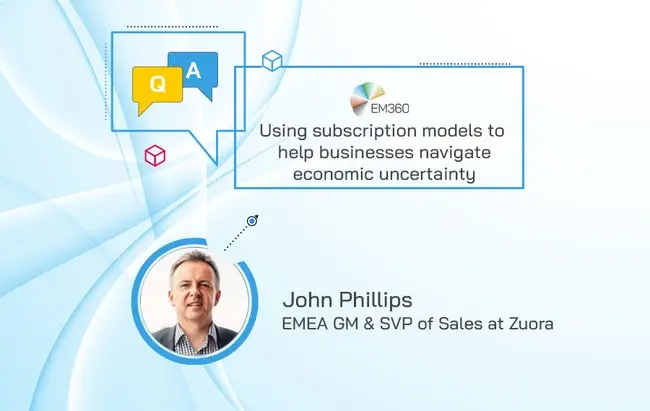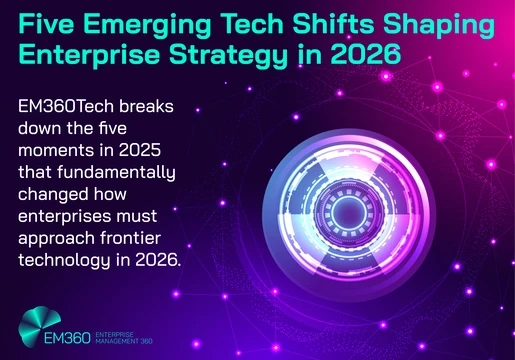Could you give us a little bit of background about who you are and your role at Zuora?

My name is John Phillips and I currently serve as Zuora’s EMEA GM and SVP of Sales.
I have over 25 years of expertise in sales leadership and general management of businesses across SaaS, Enterprise and Open Source models. During that time, I’ve worked at some of the leading technology companies - including Oracle, EMC and OpenText.
I started working at Zuora in 2014. Since then, I have led the European business throughout the company’s rapid growth to IPO and beyond.
Zuora is the world’s leading subscription management platform, providing the foundation for any company - regardless of industry - to launch, manage and scale subscription business operations. Zuora’s technology streamlines the complexity of managing and operating a subscription business - from the initial order a customer makes all the way to the way a company recognizes its revenue.
Since its inception in 2007, Zuora has grown into one of the fastest growing, high profile software companies, with a world class list of customers - including Zoom, Ford, Siemens, Schneider Electric, The Guardian, and more.
Tell us a little about Zuora’s Subscription Economy Index? What were the key findings this year?
Zuora’s Subscription Economy Index is an annual index tracking the rapid ascent of the Subscription Economy. The index analyses the health and growth of more than 500 global subscription businesses in various industries including SaaS, IoT, manufacturing, publishing, media, telecommunications, healthcare, and corporate services – in order to compare how subscription-based models are faring compared to traditional companies.
Of course, our latest report – which was released last month and features new data for the last 6 months ending June 30th 2020 – was particularly interesting, given the period of economic uncertainty that businesses are currently facing. When the global pandemic struck businesses of all sizes and in all sectors were forced to adapt quickly in order to keep afloat. And, as the ripple effects of the initial outbreak continue to impact the world’s economies, ensuring long-term stability and resilience with subscription business models is a key priority.
The latest report sheds light on how the recent pandemic has impacted buying behaviour and speaks to an accelerated preference for (and adoption of) subscription-based offerings as consumers increasingly crave convenient and flexible services and as businesses look to fortify themselves for an uncertain future. In fact, the report revealed that subscription companies continue to outperform their product-based peers by wide margins, growing revenues nearly 6X faster than S&P 500 companies (17.8% versus 3.1%). Additionally, subscription sign-ups are on the rise, and while the S&P 500 companies saw sales contract at an annualised rate of -10% in Q2, the Index reveals that subscription businesses actually expanded at a rate of 12%.
The truth is, companies with subscription models consistently demonstrate three capabilities that bolster resilience: the agility to quickly launch new revenue streams, the automation capabilities to seamlessly adapt to an increasingly digital world, and the critical customer insights needed to improve the subscriber experience. These functions differentiate subscription companies and enable them to manage for resilience—while continuing to grow—despite challenging times.
So, subscription-based models generally seem to be faring better during our current period of uncertainty, why do you think this is?
Today’s pandemic has brought about some key changes in consumer behaviour, accelerating a trend we’ve been witnessing over the years known as the end of ownership. The need to stay at home and socially distance in order to meet government guidelines has meant that buying preferences have altered and individuals sign up for services that they potentially hadn’t thought about before.
But that’s not the only reason subscription models are faring better. Subscription models are inherently more stable than their product-based counterparts for a few reasons:
First, it’s much easier to renew existing customers than chase new revenue. Each month, traditional, product-based businesses start with zero profit in the bank, whereas those implementing subscription services have a ready-made customer base. Instead of depending solely on new business, they can instead prioritise minimising churn.
Next, thanks to a substantial amount of usage data, subscription companies also know who their customers are and what they want. As a result, they can adjust their services to match demand, encouraging longer term commitment. For example, restaurant subscription app Resy did not charge its restaurants for two months during the peak of the pandemic. It also refigured its settings so that users can ‘book’ a take away. Resy’s business model enabled it to alter its services in order to reflect the current situation and help its customers bounce back.
Finally, because of the nature of providing shared services, subscription businesses are built for scale. They are able to be flexible and jump on current events in order to increase revenue. They know that consumers being encouraged to stay at home are watching more streams, reading more news, taking more online classes and videoconferencing at a never-before seen rate. A subscription model enables them to take advantage of this knowledge. It forms the basis for new launch plans, bundle offers and trial services. For example, when schools closed, Zoom launched a free service for educators. Meanwhile, news sites like the FT are dropping their paywalls for COVID-related articles, and taking advantage of the traffic to acquire new customers.
Do you see adoption increasing beyond COVID? Why is it important for businesses to get ahead now?
The demand for subscription-based services is only likely to increase as time goes by, with our recent CPG Subscription Report discovering that consumers who already have a subscription are 2x more likely to get another in the next 3 years.
Getting ahead of the game and tapping into the subscription economy now will not only help organisations to bounce back following the global pandemic. It could also boost their profitability further down the line. Those who enter the market now – and adopt subscription-based services - are preparing for a new commercial era, defined by the end of ownership.
After all, today’s consumer increasingly values access and outcomes over ownership. They want the freedom to access services and use them anytime, anywhere. They want the latest technology or model available at their fingertips at all times. They want choice in terms of how they pay, alongside the ability to pause and resume services. This trend is something that COVID-19 has propelled.
For example, during the peak of the pandemic, with supermarkets and shopping centres closing their doors and millions of households asked to stay at home, many consumers took to ordering products online. Signing up to subscription-based models became a way of ensuring that they were able to access the goods and services that they wanted and needed. Meanwhile, the popularity of subscription-based streaming services – such as Netflix, Amazon Prime and Disney+ - soared. In fact, our latest Subscription Impact Report, found that OTT video streaming services saw subscribers increase by 400% from March - May this year.
It’s fair to say that subscription-based models have witnessed a boom in popularity over the last few months, becoming a key means for businesses to ensure a stable revenue stream and for consumers to get the products and services they want in a convenient, low-cost way. And, with nearly 6 out of 10 people around the world saying they no longer wish to own things – according to our recent End of Ownership Report - it’s clear that this trend is here to stay.
How can business leaders looking to adopt a subscription-based model ensure that they are a success long-term?
Ultimately, the long-term success of subscription models relies on the monetisation of relationships. Success is not just about signing up new subscribers, but also about reducing churn. Customers need to feel like they receive ongoing value, a significant shift away from the traditional single-transaction model. Their definition of value is much more than simply a price point. Whilst saving money is important, it will often not be enough to make them stay long term. Instead, the key to long-term success is to establish strong connections through unparalleled customer experience.
Today’s consumer wants to be put in the driving seat - therefore businesses which ensure both flexibility and convenience are likely to come out on top. For example, the ability to opt-out or even just temporarily suspend a service is seen as a really important factor. Moreover, the fear of being bound to a company or service is enough to put 42% of consumers off signing up in the first place.
The delivery mechanism for the subscription must also be more convenient than traditional purchasing. It must take the pain out of tackling the high-street but still provide the experience at home for customers. There is a common thread that the most popular subscriptions will save time, deliver to the home or be something that the customer would struggle to get hold of under normal circumstances.
Customisation is also crucial when it comes to improving the customer experience. Consumers have higher expectations for a subscription model than they do with a single purchase as they are buying into a brand. Taking unique preferences into account is likely to enable businesses to build a better relationship with their customers, encouraging a longer commitment and lessening churn.
If businesses are able to deliver the right blend of flexibility, convenience and customisation, subscriptions could prove to be a sustainable solution helping them to both survive this current time of uncertainty and thrive in the future.







Comments ( 0 )